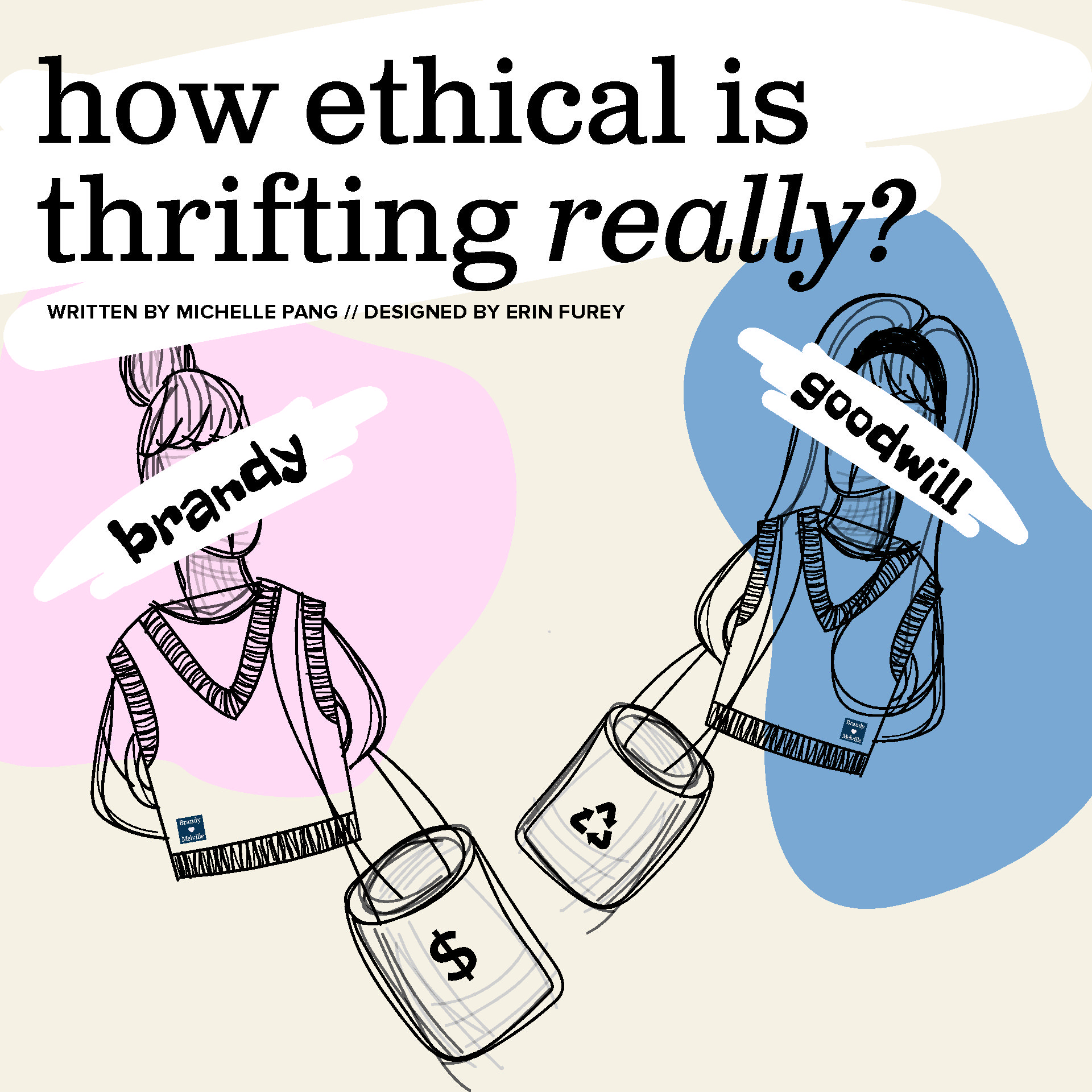
A vintage 80’s sweater in a pile at the thrift store for $7? You’ve got to be kidding me. What. A. Steal.
As a college student, buying a unique clothing item for a cheap price to spice up your closet is the most ideal situation you can find yourself in when thrifting around Boston. To many, thrifting is a three-in-one solution: reducing your clothing waste, developing your individual style, and curing your pesky retail therapy. But how ethical is thrifting really?
As students living in cities, many of us have found comfort in spending our occasional free weekends strolling around Cambridge or Back Bay, scavenging for the perfect thrifted item to add to our wardrobes. Not only is it an enjoyable activity within itself, but there are clear ethical and stylistic advantages that come with thrifting. Many college students, conscious of the negative impacts of climate change, have attempted to shift their shopping habits to increase their consumption of secondhand clothing and reduce their consumption from brands like SHEIN, H&M, Zara, etc. However, thrifting is not an all-encompassing ethical decision that directly counters clothing waste.
Those of us that treat thrifting as an activity rather than a necessity often have the means to shop wherever we would like. While a $7 sweater would definitely make less of a dent on our thin college-student wallets, many of us have the luxury of investing in a $60 sweater if we so feel inclined. What many of us overlook when hunting for that dad crewneck or vintage tee is that individuals of lower social classes have historically been thrifting simply because it is all that they can afford. By grabbing that cheap and original sweater that would perfectly pair with those mom jeans back home, we may be taking away someone’s ability to stay warm in the upcoming months.
Coming from an avid thrifter both in Boston and New York, I have personally seen the rise of notorious fast fashion brands, such as SHEIN and H&M, begin to overtake larger thrift stores like Buffalo Exchange and Goodwill. It’s become quite ironic that thrift stores, locations where people seek to mitigate their carbon footprint, have begun to house the same unethical and/or non-environmentally-conscious brands that individuals are seeking to avoid. With thrifting’s rise in popularity in recent years, thrift stores have not only been seen as somewhere to shop but also as a location to discard unwanted clothing. With the overconsumption of textiles and aggressive trend cycle, mass-produced, trendy clothing is bound to eventually fill up thrift stores as well.
It has become quite an unwelcoming surprise picking up a pair of jeans and checking its size only to find the large “SHEIN” tag staring aggressively back at me. As a consumer at thrift stores, many of us have begun to question if indirectly buying from these companies is considered ethical or not. The reality is that buying second-hand fast fashion items does quite little to curb the harms of the exploitative and wasteful industry. By repurchasing these momentarily timely items, we are still showcasing that Brandy Melville sweater vest or Fashion Nova top to the world on our own bodies and inadvertently inspiring others to contribute to buying new fast fashion items. Given these items’ trend expiration date, they are likely to end up back in the thrift store or in a landfill within a year’s time.
It’s important to recognize that buying secondhand clothing, whether it’s completely original or something from Zara, is still a more ethical decision than buying an entirely new item from a fast-fashion company. Thrifting is a solution to the overconsumption of clothing waste and is most definitely a step in the right direction.
As a day-to-day consumer, it’s not realistic to expect individuals to be hyper-aware of all the intricacies of how ethical each individual item they’re picking up is. However, this does not mean we cannot be conscious of how we approach thrifting as a whole. All these ethical obstacles seem nearly impossible to navigate. They highlight the question: So, how exactly do I thrift ethically?
Begin by choosing thrift stores in more middle to upper-middle-class neighborhoods. Not only might you pick up some wealthy grandma’s nifty cardigan, but you’ll also be more likely to be buying someone’s vintage clothing, rather than taking away someone’s resource. For those local to Northeastern, make your way over the Harvard Bridge and visit The Garment District, Boomerangs, and Goodwill for some interesting and ethical vintage pieces!
From a stylistic perspective, be selective with the items you decide to add to your closet. Before purchasing an item, ask yourself: Do I see myself wearing this in five or ten years, or is it something I’ll stuff in the back of my drawers after three months? Is this really a unique statement piece, or is it actually ugly? Is this item made well? How long will it actually last? By implementing these criteria into your buying decision process, you’ll be creating your personal wardrobe catered to your long-term style. Lastly, try to establish your individual style beyond the current trends. A piece of clothing is always more fun when it’s uniquely your own. If that atrociously yellow raincoat or burgundy cable knit sweater genuinely makes you feel confident, wear it! The clothes we put on our body are a reflection of ourselves, and it’s important that we’re proud of the image that we portray. Being fashionable does not mean you have to compromise your ethics. So, let’s act that way.